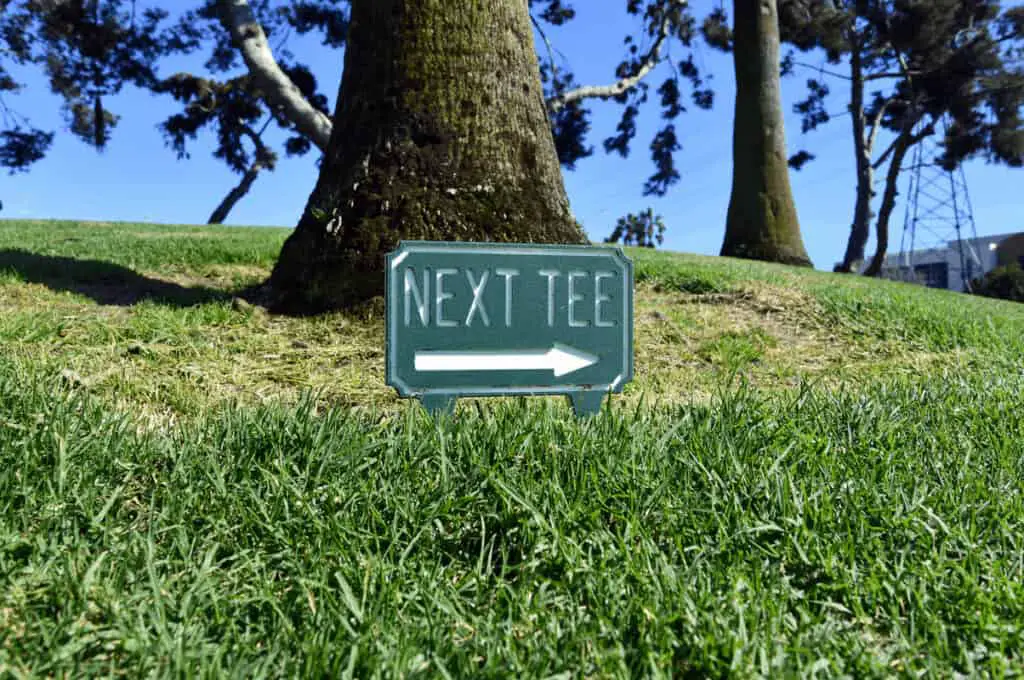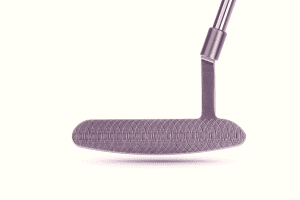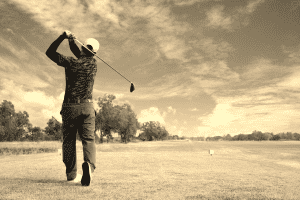Whether you’re brand new at the game or progressing toward being a scratch golfer, most players find themselves wondering at one point or another how they stack up against the world. What does the average golfer shoot? What is a good score? The truth is that there are a few factors to be considered- age, gender, etc. Some players are out there daily, while others barely see the course.
These questions will come up time and again, and instead of wondering or making up some statistic with a friend, we wanted to give you all the information you could ever need, right at your finger tips.
Want to know the average golf score? See how you stack up against the rest of the golfing world? And best of all, get a couple of useful tips on how to shoot better scores? Check out our answers to some of these commonly asked questions below.
What is The Average Golf Score for 18 holes?
We had to do some digging to figure this out, but according to the US Golf Association which is responsible for tracking golfer data, the average golf score on 18 holes for a recreational golfers is around 93. Now, this needs to be taken with a slight grain of salt; not all golfers log their rounds into the system, and many of your weekend golfers tend not to as well. So while the data shows a 93, the reality is that the average golfer struggles to shoot below 100 on any given day.
The interesting thing about this average score is that it has largely stayed stagnant for more than a decade. While technology, equipment and resources have been advancing rapidly, golf scores have not dropped at all. Moral of the story here? Golf is hard. Cut yourself some slack on a bad round or a bad day at the course!
Measuring Your Skill: Average Handicap
While measuring your strokes in a round is a measure of how you played on the day, the Handicap system dives deeper into how you tend to play overall. A golf handicap is way to measure your personal skill level and how you fall onto the spectrum of golfers. It can also help you indicate how you may shoot at different courses, which we can get into shortly. Effectively, the handicap system can tell you what’s a good score for you, and what’s a bad score for you.
So what is the average handicap? The handicap system breaks down players by gender- the average male handicap is currently 14.2. The average female handicap is currently 27.5 Below are two visual breakdowns of handicaps by gender.
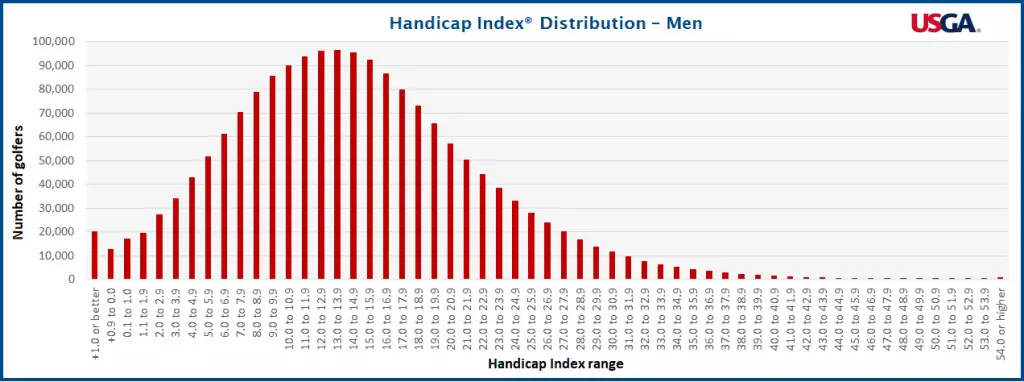
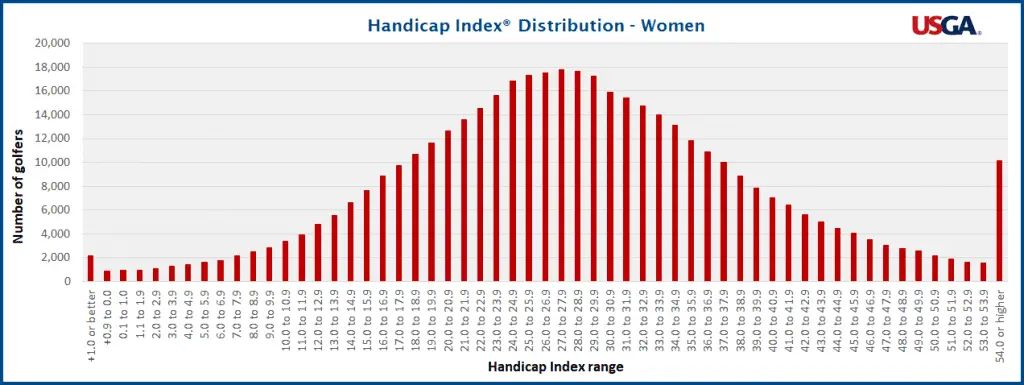
Want to feel better about how you play? Less than 3 percent of male golfers are below a 1 handicap. On the other side of this, a whopping 97 percent of golfers would struggle to shoot in the low 70s more than a handful of times per season. There are about 20,000 male golfers who have a +1 or better handicap index (expected on a good day to shoot 1 under par). Great golfers are a rare breed.
We have a deep dive guide on the handicap system, so if you want to check that out, here it is.
What is a good score in golf?
This is highly subjective, and it will boil down to your skill level and your handicap. For Justin Thomas, a good score might be 66 on a par 72, which simply isn’t realistic for anyone who doesn’t play the game professionally. If you’re a 10 handicap, 78-82 is going to be a good score; that’s shooting at or below your handicap on a par 72, and effectively realizing your full potential. On the same note, as a 10 handicap you’d probably consider a 92 a pretty bad round. As a 20 handicap, a 92 is a pretty solid accomplishment.
A good score is more about how you feel like you played compared to your ability, rather than being compared to anything else.
Course Rating & Slope Rating Information
There’s more to the average golf score than just the raw stroke number- you need to take course difficulty into play as well! For that reason, every golf course you’ll visit has a Course Rating; in lament terms, each course is assigned a number that a scratch player would be expected to shoot on that course. There are many factors that go into a course rating, including fairway measurement, green measurement, bunker depth, and other various obstacles. Each of variables are considered and measured in order to come up with a probable score for a scratch player. So if a Course Rating is 74 from the Blue tees, a scratch player is expected to be able to shoot a 74.
Another metric paired with Course Rating is Slope Rating; you’ll find a slope rating at every golf course you play as well. According to the USGA, the Slope Rating of a golf course measures the relative difficulty of a golf course for golfers who aren’t scratch players, compared to those who are. This rating is made by comparing the Course Rating and the Bogey Rating; a Slope rating can be anywhere between 55 and 155, with the average being around 113. A Slope Rating above 113 indicates a Course Rating will be higher, and below 113 it will be lower.
Improving Your Scores
So know you’ve got some basics on what an average score looks like in some respects, but I’m sure you’re interested in lowering those scores. There are some key areas that any golfer can look at to get better, shoot lower scores and ultimately lower their handicap. Shooting lower scores just makes the game more fun.
Below are a few of our top suggestions for any golfer:
Play the Mental Side of the Game
Believe it or not, the biggest difference between high handicappers and low handicappers is their mental approach to the game of golf. There’s a saying that golf is 80% mental, and for the most part that’s true; you need a bit of skill, but once you have the basics your mental game truly can take you to the next level. So how do you work on the mental side? For one, there are some great books out there- my favorite being “Golf is Not a Game of Perfect” by Bob Rotella.
Beyond some studying? Be positive. Be your own best friend and cut yourself some slack on the golf course. Play conservative shots, but play them with full commitment, and play within the confines of your own game. Hero shots tend to result in penalties, and going for the pin every time can do more harm than good. I know this is all quite generic, but digging into the mental side is what will take you to the next level.
Focus on Fundamentals
One of the very first things to look at when it comes to improving your golf scores is naturally going to be making sure you work on those fundamentals. If you don’t have a swing that you can repeat, and have some idea where the ball is going to go, it’s going to be very very difficult to put up any sort of good scores. Pay attention to the basics: alignment, posture, and general set up first. If you can nail those pieces, the entire golf swing is so much easier.
Honestly, if you’re a high handicapper, or a mid handicapper who wants serious improvement, a golf instructor will help you hone in on the right things to focus your energy on. $250 on lessons will go much further than $250 on new golf clubs. If you want to get better as quickly as possible, this is your best route. If you don’t have budget for a coach, there are a ton of free resources available on Youtube and all over Google in general. Not as good, but better than nothing.
If you’d like an additional resource on setup. we’ve got a comprehensive guide for you to check out here.
Appreciate the Small Wins
When you’re working on becoming a better golfer, there will be a lot of frustrating days. There will always be shots that disappoint you, or rounds you wish you could’ve played better. With all the frustration that surrounds golf, it can actually end up being depressing when things aren’t going your way, which can lead to further performance declines. This is why you need to appreciate your small wins. When you hit a great drive, or a perfect 9 iron, make sure you soak in the moment. Appreciate that you’re capable of hitting excellent golf shots. Appreciate the long putts that drop, and don’t pay any attention to the ones that don’t.
Soaking in some of these moments and harnessing the feeling of hitting a good shot can actually help you play better in the long run. Getting better at golf is a journey, so learning to appreciate that is critical for improving your game.
Final Thoughts
Well there you have it; the average golf score in America as around 92. But in reality, when you consider how many golfers don’t log their data, that average is much closer to 100 or higher. We also looked at some key handicap data, which showed the average male handicap to be around a 14.2, while the average female handicap is 27.5. Yes, these are the official averages, but everyone out there is different. For the most part, it really only makes sense to compare your scores to your own average scores, and try to improve on those!
Improving your golf game can be a long road; ultimately it takes time, mental game, strong fundamentals, and the patience to appreciate the journey. Good luck on yours, and thanks for reading1

